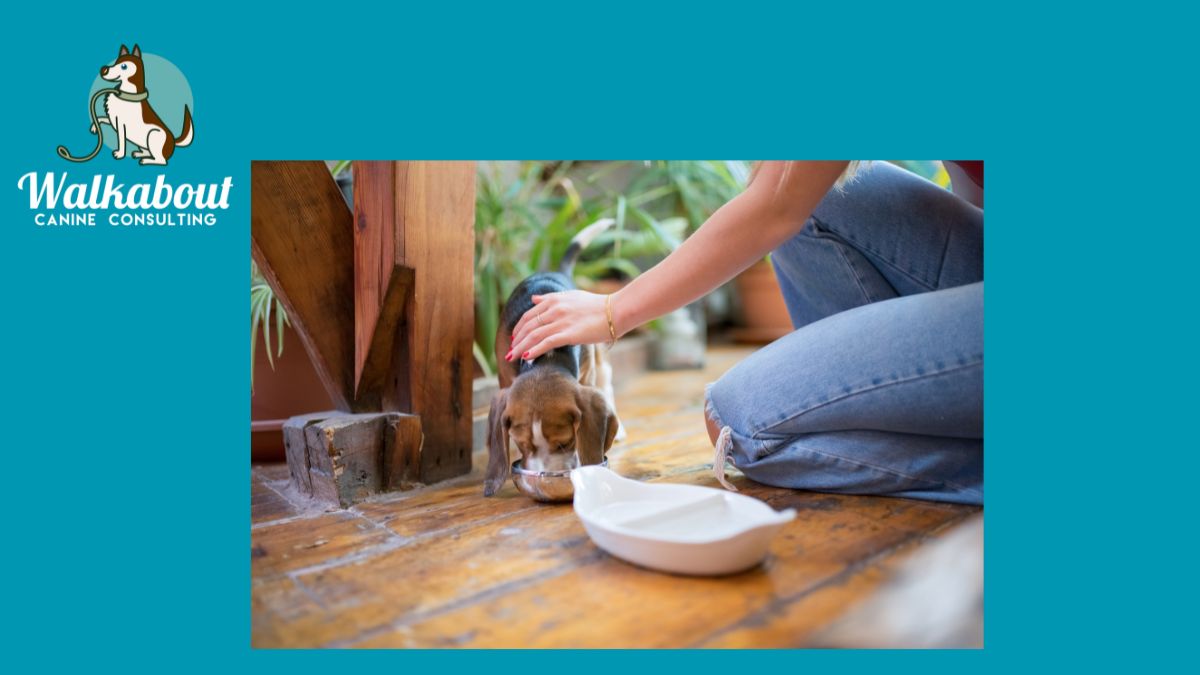Positive Dog Training & Behaviour Blog | Walkabout Canine Consulting
Unleashing your dogs potential, one concept at a time
Touching our Dogs while they eat

Why this is not a good plan for resource guarding prevention
Respecting Mealtime: How to Prevent Resource Guarding in Puppies
Food is one of the most valuable resources in a dog's life. Mealtime is not just about nutrition; it’s a moment of vulnerability, especially for puppies learning to navigate their environment. Many well-meaning dog guardians make the mistake of touching, petting, or interrupting their puppy while eating, believing it will help prevent resource guarding. However, this approach often backfires, creating insecurity around food instead of trust.
In this article, we’ll explore why interfering during mealtime can contribute to resource guarding and what to do instead to foster a positive relationship with your puppy and their food.
Why Interrupting a Puppy’s Meal Can Lead to Resource Guarding
1. Eating is a Vulnerable Activity
For dogs, eating is an instinctual behaviour that requires a sense of security. In a natural setting, a dog would find a safe place to eat, free from competition or threats. When a puppy is repeatedly disturbed during meals, they may start feeling uneasy, leading to stress and tension. Over time, they might anticipate interruptions and react defensively, seeing any approach toward their food as a potential threat.
Early signs of discomfort during eating include:
- Stiffening of the body
- Eating faster when approached
- Freezing with their head over the bowl
- Giving side-eye (whale eye)
If these signs are ignored and the puppy is repeatedly disturbed, they may escalate to growling or snapping as a way of communicating their discomfort.
2. Mixed Signals: Is It Rewarding or Stressful?
Some dogs enjoy petting or engagement while eating, but others find it distracting or even aversive. When a dog does not enjoy being touched while eating, repeated attempts to do so can cause anxiety.
If a puppy perceives human hands near their bowl as a negative experience, they may feel the need to protect their food. This is why it’s crucial to observe individual body language and respond appropriately rather than assuming all dogs will react the same way.
3. The Build-Up of Frustration
Puppies should feel secure when eating. If they are frequently interrupted, prodded, or engaged in an attempt to “test” their tolerance, frustration can build. Frustration is often a key precursor to resource guarding.
Imagine if every time you sat down to eat, someone reached over your plate or took a bite of your meal. Over time, you might start feeling defensive, eating faster, or even snapping at the intruder. The same logic applies to puppies. Constant interference with their food teaches them that humans may take away what they value, increasing the likelihood of resource-guarding behaviours.
4. Mistrust Can Develop Over Time
If a puppy learns that humans always interfere when they have a valued resource, they may begin guarding preemptively. This could mean stiffening, growling, or even lunging when someone approaches their bowl—not because they are aggressive, but because they have learned that human presence during meals equals discomfort or loss.
The good news is that resource guarding can often be prevented through trust-building exercises rather than by forcing tolerance through unnecessary interference.
What to Do Instead: Setting Your Puppy Up for Success
Instead of disrupting mealtime, try these strategies to create a positive association with human presence around food.
1. Allow Your Puppy to Eat in Peace
One of the simplest ways to prevent resource guarding is to respect your puppy’s space during meals. Give them a designated, quiet area where they can eat without feeling pressured or threatened.
If you have multiple dogs, consider feeding them separately to reduce competition and anxiety around food.
2. Build Positive Associations with Approaching Hands
Instead of testing your puppy’s tolerance by touching or taking their food away, create positive experiences around your presence near their bowl.
Try this exercise:
- Occasionally walk by while your puppy is eating and drop a high-value treat (such as a small piece of chicken or cheese) into their bowl.
- Walk away without engaging further.
- Repeat this occasionally—not every meal—to reinforce that your approach means good things, not loss or interference.
If your puppy stiffens or eats faster when you approach, take a step back and give them more space before resuming this exercise at a later time.
3. Establish Predictability in Mealtime Routines
Dogs thrive on routine. Keep meal times consistent so your puppy knows what to expect. Avoid unpredictability, such as taking food away mid-meal or frequently changing feeding locations.
Predictability builds confidence, which reduces the likelihood of stress-based guarding behaviours.
4. Teach a Positive Trade Cue (Optional)
If you ever need to take something from your puppy (e.g., if they grab something unsafe), a positive trade can be useful. Start by teaching a "drop" or "trade" cue using two equally valued toys. Once they consistently release one toy for another, you can introduce food-related trades using a high-value treat in exchange for a lower-value food item.
Important: Avoid trading too often, or your puppy may begin to anticipate loss, leading to guarding instead of trust.
Final Thoughts: Trust Over Tolerance
The goal isn’t to teach puppies to "tolerate" interruptions but rather to prevent them from feeling the need to guard in the first place. By creating a stress-free mealtime routine and reinforcing positive associations, you help your puppy build confidence and trust.
Key Takeaways:
✅ Respect your puppy’s space while eating.
✅ Avoid testing their tolerance by petting or removing food unnecessarily.
✅ Build positive associations with human presence near food.
✅ Maintain a predictable mealtime routine.
✅ Teach a positive trade only when necessary.
With patience and the right approach, you can help your puppy develop healthy eating habits and a trusting relationship with humans around food.
Categories: : advolescent dogs, dog resource guarding reason, dog training, puppy training
 Sylvia Koczerzuk Koczerzuk
Sylvia Koczerzuk Koczerzuk 
